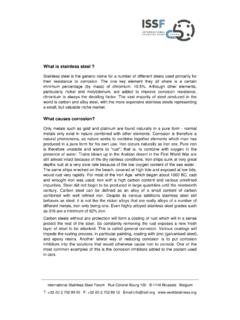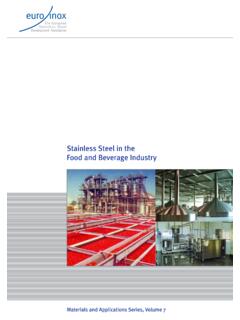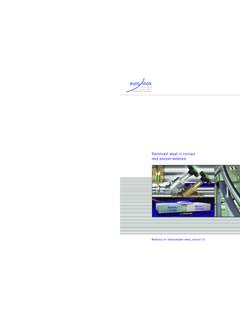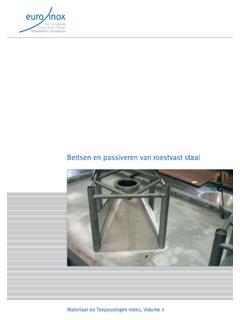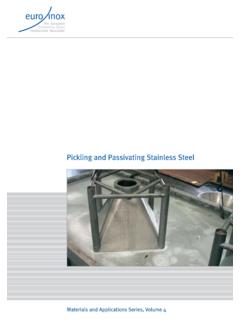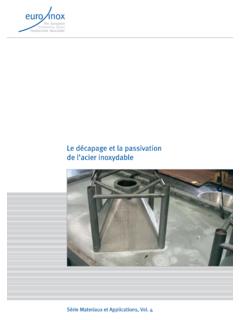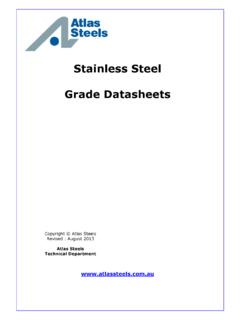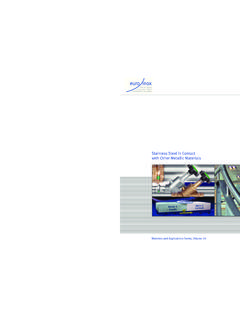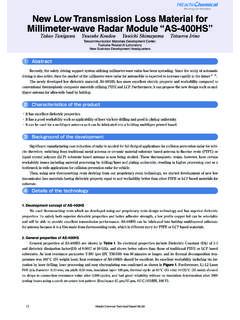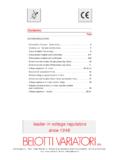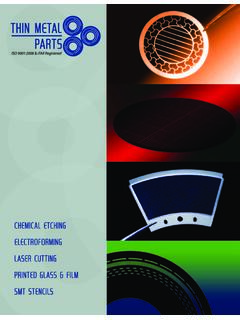Transcription of Electropolishing Stainless Steels
1 Materials and Applications Series, Volume 11 Electropolishing Stainless SteelsEuro InoxEuro Inox is the European market development asso-ciation for Stainless of Euro Inox include: European Stainless steel producers national Stainless steel development associations development associations of the alloying element industriesThe prime objectives of Euro Inox are to create aware-ness of the unique properties of Stainless steel and to further its use in existing applications and in new mar-kets. To achieve these objectives, Euro Inox organises conferences and seminars, issues guidance in printed and electronic form to enable architects, designers, specifiers, fabricators and end users to become more familiar with the material. Euro Inox also supports technical and market 978-2-87997-310-4978-2-87997-311-1 German version978-2-87997-312-8 Finnish version978-2-87997-313-5 French version978-2-87997-314-2 Italian version978-2-87997-315-9 Dutch version978-2-87997-316-6 Polish version978-2-87997-317-3 Spanish version978-2-87997-318-0 Swedish version978-2-87997-319-7 Czech version978-2-87997-320-3 Turkish versionFull Stainless BelgiumArcelorMittal Stainless Acciai Speciali Terni Stainless Steel Association (BSSA) Edelstahl Chromium Development Association (ICDA) Molybdenum Association (IMOA) Nickel Institute Paslanmaz elik Derne i (PASDER) Unia Dystrybutor w Stali (PUDS) Stainless STEElSElectropolishing Stainless SteelsFirst Edition 2010(Materials and Applications Series, Volume 11) Euro Inox 2010 EditorEuro InoxDiamant Building, Bd.
2 A. reyers 801030 Brussels, BelgiumTel.: +32 2 706 82 67 Fax: +32 2 706 82 69E-mail: Kosma , Brussels (B)AcknowledgementsEuro Inox wishes to thank Mr. Siegfried Pie linger Schweiger, Poligrat (D) and Mr. John Swain, Anopol (UK) for their contributions and their critical reading of the draft page photograph: Packo Surface Treatment, Diksmuide (B)DisclaimerEuro Inox has made every effort to ensure that the information presented in this document is techni-cally correct. however, the reader is advised that the material contained herein is for general information purposes only. Euro Inox, its members, specifically disclaim any liability or responsibility for loss, dam-age, or injury, resulting from the use of the informa-tion contained in this Introduction 22. The principle 43. Process steps Metal preparation Electropolishing Post-treatment 84. Electropolishing vs. other surface-finishing techniques Mechanical polishing Electroplating 105.
3 Specifying electropolished finishes 116. Typical applications 127. Glossary 158. references 17 Copyright noticeThis work is subject to copyright. Euro Inox reserves all rights of translation in any language, reprinting, re-use of illustrations, recitation and broadcasting. No part of this publication may be reproduced, stored in a retrieval system or transmitted in any form or by any means, electronic, mechanical, photocopying, record-ing or otherwise, without the prior written permission of the copyright owner, Euro-Inox. Violations may be subject to legal proceedings, involving monetary dam-ages as well as compensation for costs and legal fees, under luxembourg copyright law and regulations within the European Stainless STEElS2 Electropolishing Stainless STEElSElectropolishing is a chemical surface-finishing technique (see box), by which metal is electrolytically removed, ion by ion, from the surface of a metal object [1].
4 The primary objective is to minimize micro-roughness, thus dramatically reducing the risk of dirt or product residues adhering and improving the cleanability of surfaces. Electropolishing is also used for deburring, brightening and process exposes an undisturbed, met-allurgically clean surface. Possible unwant-ed effects of mechanical surface treatment mechanical and thermal stress, embed-ding of particles and surface roughening are avoided or reversed. The inherent corrosion-resistance of a given Stainless steel grade is fully used. For these reasons, Electropolishing has become a common treatment for Stainless steel in industries in which corrosion-resistance and cleanability requirements are particularly high. Typical applications are found in the pharmaceu-tical, biochemical and food-processing Electropolishing involves no mechan-ical, thermal or chemical impact, small and mechanically fragile parts can be treated.
5 Electropolishing can be applied to parts of almost any shape or IntroductionElECTroPolIShING Stainless STEElS3 Chemical surface treatments: when to consider what and whyThere is a range of different chemical surface treatments. Although these all contribute to producing a clean metallic surface and have overlapping effects, they have distinctly dif-ferent purposes:PicklingPickling removes oxides specifically heat tint (from welding) and other discolourations or corrosion products. It creates a clean metallic surface that provides the conditions necessary for the natural self-passivation of Stainless steel to take place. Typical compo-sitions involve nitric acid and hydrofluoric acid. Treatment time depends on the tem-perature of the solution and the degree of self-passivation of Stainless steel nor-mally takes place spontaneously in the presence of oxygen from air or water. however, it can take a couple of days before the passive layer develops its full thickness.
6 Chemical passivation treatment speeds up the formation of the passive layer, ensuring that it builds up quickly to its full strength, under controlled conditions. Passivation is performed in diluted nitric acid, the treat-ment time varying between 15 minutes and 1 or acid cleaningThis removes ferrous particles which would corrode if left on the Stainless steel surface for example when Stainless steel parts have been exposed to ferrous contaminants (grind-ing dust, rust particles from adjacent work on carbon steel, abrasion from tools, etc.)1 ElectropolishingElectropolishing is applied to clean metallic surfaces, to reduce micro-roughness and produce a number of other highly desirable effects, described in this publication. The process depends on the principle of elec-trolysis, involving a flow of current and a solution of mostly sulphuric acid and ortho-phosphoric acid as an electrolyte.
7 Treatment times are usually between 2 and 20 cf. CrooKES, roger, Pickling and Passivating Stainless Steel, luxembourg: Euro Inox, Second edition 2007 (Materials and Applications Series, Volume 4) Stainless STEElS2 The principleElectropolishing is an efficient method of deburring even in parts that would be dif-ficult to treat mechani-cally. Photo: Poligrat, Munich (D) Electropolishing removes metal from a workpiece by passing an electric current while the workpiece is submerged in an electrolyte of a specific composition. The process is essentially the reverse of elec-troplating. In a plating system, metal ions are deposited from the solution onto the workpiece. In an Electropolishing system, the workpiece itself is eroded, adding metal ions to the solution. A typical Electropolishing installation is similar in appearance to an electroplating line. A power source converts AC current to DC at low voltages.
8 A tank fabricated from plastic or lead-lined tanks is commonly used to hold the chemical bath. A series of lead, copper or Stainless steel cathode plates are lowered into the bath, to the negative (-) side of the power source. A part or group of parts is fixed to a rack made of titanium, copper or bronze. That rack in turn is coupled to the positive (+) side of the power workpiece is thus connected to the pos-itive (anodic) terminal, while the negative (cathodic) terminal is connected to a suit-able conductor. Both positive and negative terminals are submerged in the electrolyte, forming a complete electrical circuit. The current applied is direct (DC) the adjoining illustration shows, the metal part is charged positive (anodic) and immersed in the chemical bath. When cur-rent is applied, the electrolyte acts as a conductor ( tool ) to allow metal ions to be removed from the part. While the ions are drawn toward the cathode, the majority of the dissolved metals remain in solution.
9 Some ions are deposited in sludge form on the cathodes, which require regular clean-ing for efficiency. Gassing, in the form of oxygen, occurs at the metal surface, fur-thering the electrolytic action. The quantity of metal removed from the workpiece is proportional to the current applied, the efficiency of the electrolyte and the exposure time. In the course of Electropolishing , burrs and other projec-tions become areas of very high current density and are preferentially eroded. The workpiece process parameters are set to control the amount of metal removed, so dimensional tolerances are maintained. Electropolishing Stainless STEElS5 The workpiece being the anode of the electro-chemical process, ma-terial is removed from the surface [3].A microscopic view of the same surface before and after electopolishing shows that the process produces clean metal-lic surfaces. Photo: Poligrat, Munich (D)In the case of Stainless steel, the various ele-ments, which make up the alloy, are removed at different rates.
10 Iron and nickel atoms are more easily extracted from the crystal lattice than are chromium atoms. The elec-tropolishing process removes the nickel and the iron preferentially, leaving a sur-face rich in chromium. This phenomenon accelerates and improves the passivation of electropolished surfaces[2].The fact that Electropolishing is a non-distortion process is often overlooked. Electropolished parts are neither subject to mechanical nor thermal stress from pol-ishing media, nor are they impinged or tumbled [4].The results can be reproduced with a high degree of precision, so components with tight tolerances can also be treated safely2. 2 Given proper process control and procedures, there are no safety hazards, if competent Electropolishing contractors are employed who ensure that efficient ventilation systems are used during the process. These operators should also dispose of waste materi-als, including spent acids, using approved, safe erTankrackCathodeCathodeWorkpiece(Anode) heaterElECTroPolIShING Stainless STEElS3 Process stepsTo obtain high-quality electropolished fin-ishes on most Stainless steel alloys, the work must be performed in three major operations [5]: Metal preparation: to remove surface oils, greases, oxides and other contami-nants that interfere with the uniformity of Electropolishing Electropolishing : to smooth, brighten and/or deburr the metal Post-treatment: to remove residual elec-trolyte and by-products of the electropo-lishing reaction and dry the metal to prevent of these major operations may involve several tank stations to achieve the desired result.

